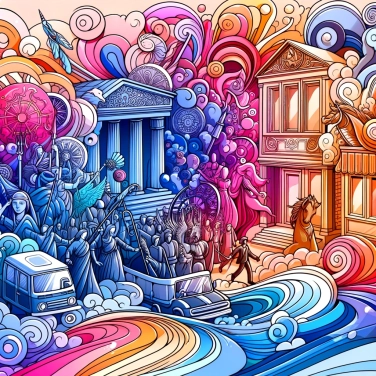The fall of the Western Roman Empire marked the end of Antiquity in Europe as it led to the disintegration of the Roman political and economic organization, thus paving the way for major social, cultural, and political changes in the region.

The fall of the Western Roman Empire is mainly a large political void. Rome could no longer effectively manage its provinces, and various generals or governors wanted their share of the pie. As a result, central authority gradually collapses, and the very notion of Empire becomes blurred. People, who until then looked to Rome for their security, find themselves at the mercy of local leaders or outside invaders. Without a strong Roman power, Western Europe divides into many small kingdoms, ruled by local leaders or barbarian chiefs. This political fragmentation clearly marks the end of an era: goodbye Roman unity, hello the beginnings of the medieval period.
The end of the Western Roman Empire was largely marked by significant unrest linked to barbarian migrations. Starting from the 4th century, numerous peoples from the east and north of Europe, such as the Visigoths, the Franks, the Vandals, and the Burgundians, crossed the Roman borders and settled directly within the imperial territory. This profoundly disrupted the European population: people moved around a lot, some cities emptied or completely changed their appearance. These new populations gradually imposed their own cultures, languages, and customs, mixing with local populations to create a complete demographic blend that entirely reshaped the human and cultural map of Europe. In short, post-Rome Europe became a lively jumble of peoples, blending ancient Latin traditions with new cultures arising from the barbarian invasions.
The gradual collapse of the central Roman power triggers a real economic crisis. Trade becomes risky, roads are no longer secure, and long-distance trade is seriously failing. As a result, many cities that heavily relied on these exchanges lose their prosperity. Inhabitants gradually desert these once-dynamic cities, preferring to settle in the countryside where they can at least produce their own food. The result: ancient cities shrink visibly, many public buildings fall into ruin, and the urban organization typical of Roman antiquity gradually disappears to make way for a more rural, isolated, and self-sufficient lifestyle.
With the gradual decline of Roman authority, the cultural dynamism of the empire slowly waned. Fewer people were proficient in classical Latin, which was gradually evolving into distinct regional languages. Classical education, based on the study of ancient texts, was increasingly abandoned, reserved mainly for a few monasteries or rare learned individuals. The arts and sciences of antiquity were losing their prominence, replaced by simpler styles and everyday or religious concerns. Europe was progressively entering a period dominated by a medieval Christian culture, centered around the church and its institutions. The great ancient libraries were also slowly disappearing, and the majority of ancient knowledge was lost or confined to a few isolated locations until its gradual rediscovery several centuries later.
The fall of Rome also resulted in a temporary loss of technical and scientific knowledge in many European regions. This phenomenon, long dubbed the 'Dark Ages', is now nuanced by many historians as a complex and transitional period rather than a complete 'dark phase'.
The traditionally accepted date for the fall of the Western Roman Empire is the year 476, when Odoacer, a Germanic leader, deposed the last Western Roman emperor, Romulus Augustulus. However, the Eastern Roman Empire, or Byzantine Empire, endured until 1453.
Following the disintegration of the empire, Europe saw the emergence of several barbarian kingdoms such as the Visigoths in Spain, the Ostrogoths in Italy, and the Franks in present-day France. These kingdoms laid the foundations for future European nations.
Many Roman roads and infrastructures remained functional long after the fall of the empire. Some ancient Roman routes still serve as the foundation for modern roadways across Europe today.
Several so-called 'barbarian' peoples contributed to the destabilization and eventual fall of the Western Empire. Among them, the Visigoths, Ostrogoths, Vandals, Franks, Burgundians, and Huns are often mentioned.
The fall of the Western Roman Empire is generally seen as a major turning point between Antiquity and the Middle Ages. This period witnesses the decline of the Roman administrative model, political fragmentation, demographic changes related to barbarian migrations, and a weakening of ancient urban civilization, gradually plunging Europe into a time of significant cultural and social change.
After the fall of the Western Roman Empire, the European economy experienced a significant regression. Large-scale trade declined, Roman road and commercial infrastructure were neglected, and cities faced a notable decline, leading to an economy that was increasingly based on rurality and agriculture.
No, the Eastern Roman Empire, also known as the Byzantine Empire, survived for nearly a thousand more years. Its capital, Constantinople, fell only in 1453, marking another major turning point in European history with the transition to the modern era.
The effective fall of the Western Roman Empire is generally associated with September 4, 476 AD, the date when the last Roman emperor of the West, Romulus Augustulus, was deposed by the barbarian leader Odoacer.

100% of respondents passed this quiz completely!
Question 1/5